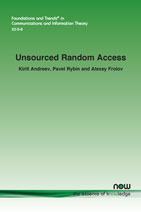Unsourced Random Access
By Kirill Andreev, Skolkovo Institute of Science and Technology, Russia, k.andreev@skoltech.ru | Pavel Rybin, Skolkovo Institute of Science and Technology, Russia, p.rybin@skoltech.ru | Alexey Frolov, Skolkovo Institute of Science and Technology, Russia, al.frolov@skoltech.ru
Abstract
Current wireless networks are designed to optimize spectral efficiency for human users, who typically require sustained connections for high-data-rate applications like file transfers and video streaming. However, these networks are increasingly inadequate for the emerging era of machine-type communications (MTC). With a vast number of devices exhibiting sporadic traffic patterns consisting of short packets, the grant-based multiple access procedures utilized by existing networks lead to significant delays and inefficiencies. To address this issue the unsourced random access (URA) paradigm has been proposed. This paradigm assumes the devices to share a common encoder thus simplifying the reception process by eliminating the identification procedure. The URA paradigm not only addresses the computational challenges but it also considers the random access (RA) as a coding problem, i.e., takes into account both medium access protocols and physical layer effects. In this monograph we provide a comprehensive overview of the URA problem in noisy channels, with the main task being to explain the major ideas rather than to list all existing solutions.
Unsourced Random Access
Current wireless networks are designed to optimize spectral efficiency for human users, who typically require sustained connections for high-data-rate applications like file transfers and video streaming. However, these networks are increasingly inadequate for the emerging era of machine-type communications. Machine-type communications (MTC) dramatically change traffic patterns. Instead of focusing on peak data rates and low latencies, massive connectivity becomes a key requirement. The MTC concept involves a massive number of autonomous devices and sensors being connected to a gateway: a node (or a set of nodes) responsible for data collection. With a vast number of devices exhibiting sporadic traffic patterns consisting of short packets, the grant-based multiple access procedures utilized by existing networks lead to significant delays and inefficiencies. To address this issue, the unsourced random access (URA) paradigm has been proposed. This paradigm assumes the devices to share a common encoder thus simplifying the reception process by eliminating the identification procedure.
The URA paradigm not only addresses the computational challenges but it also considers the random access (RA) as a coding problem, i.e., takes into account both medium access protocols and physical layer effects. This monograph provides a comprehensive overview of the URA problem in noisy channels, with the main task being to explain the major ideas rather than to list all existing solutions.
